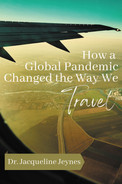At the beginning of 2020, travel and tourism sectors were a growing, thriving industry. Mature travelers were seen as the ones with more disposable income, wanting to take two to three holidays/trips each year and looking for new experiences globally. Younger age groups were more likely to plan a trip at shorter notice, often preferring social media platforms that included UGIs (user-generated images) and positive influencer feedback.
Going forward two years, it was clear that the COVID-19 pandemic had completely changed options for travel and, indeed, views of individuals about how/where/whether to travel outside their home country. The excitement and spontaneity of poring over a map and choosing a new destination, as in Figure F.1, may take a bit longer to resurface.
Looking back at travel and tourism, we can see how restrictions introduced around the world impacted on everyone’s views of where they could visit. This overview of how options for travel changed leads directly to where we want to be as we get used to a new form of “normal.” While no one is sure at what stage the pandemic becomes an endemic disease—more like the usual flu occurring in “seasonal or predictable cycles” (E.Murray Boston University) and therefore we have some sort of control over it—it will be a while before all precautions can be relaxed. It is important, therefore, to identify the critical issues that must be addressed if travel and tourism sectors are to survive in the future.

